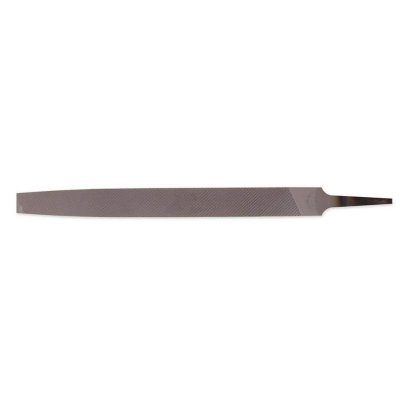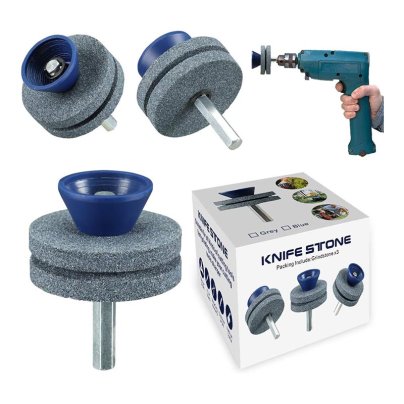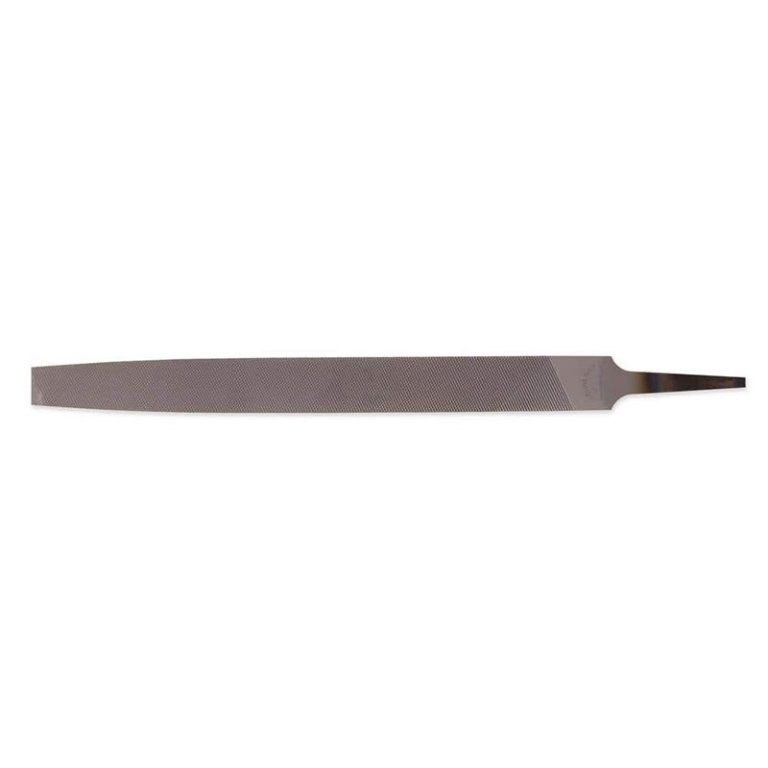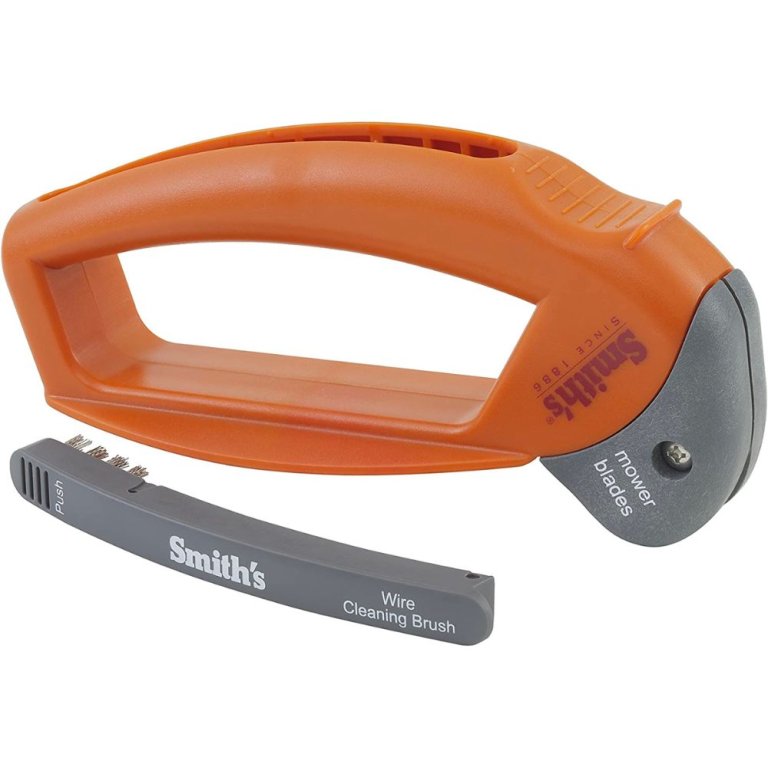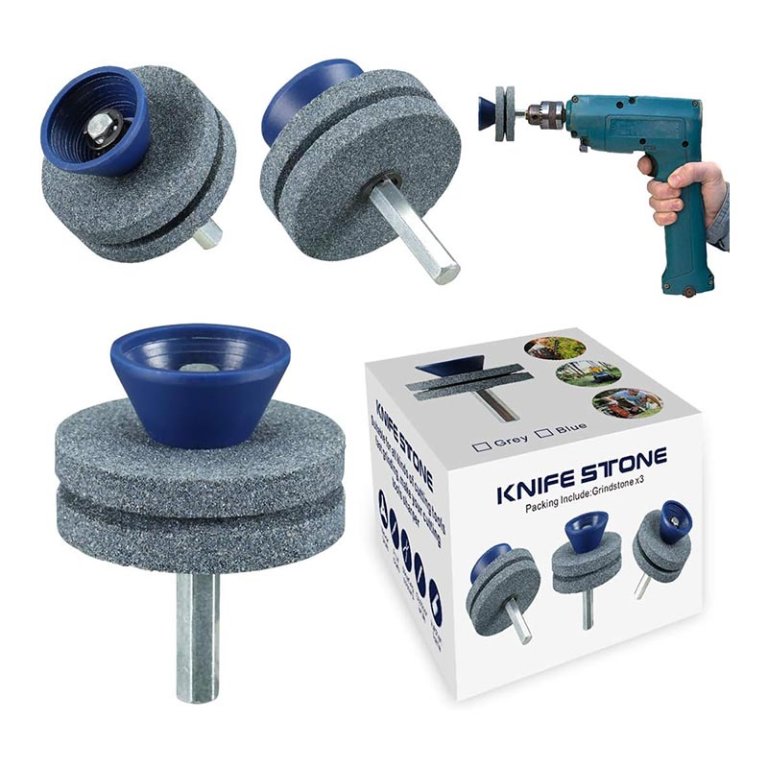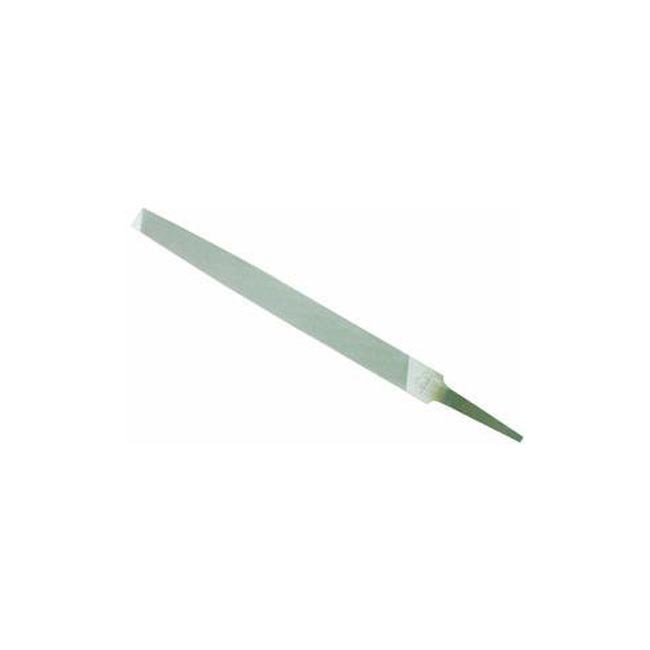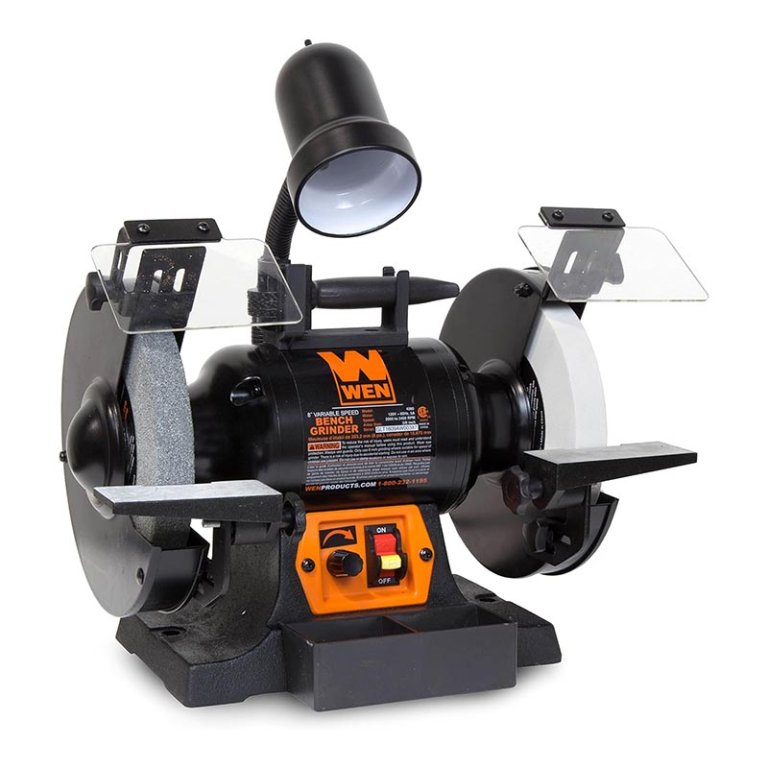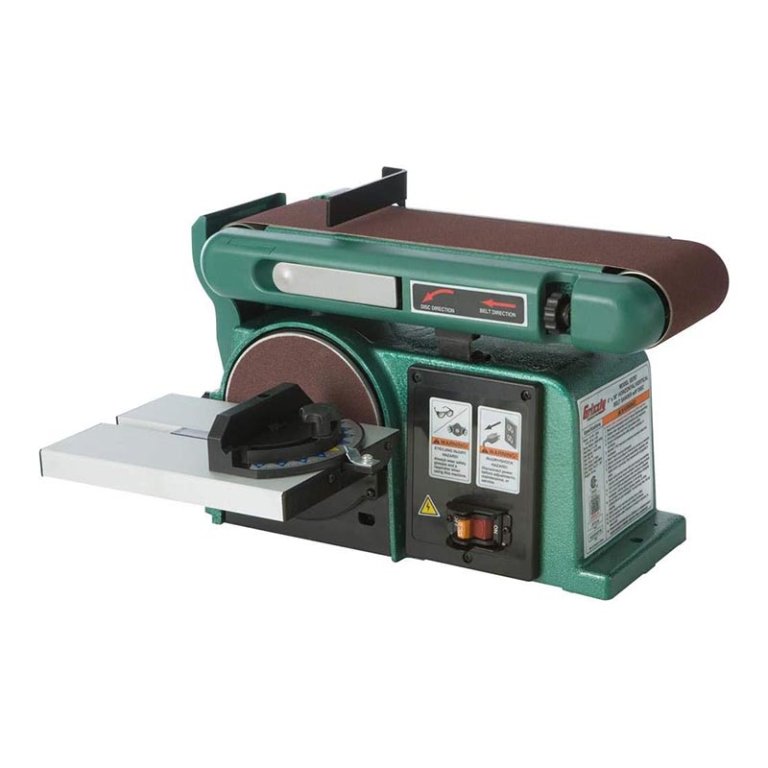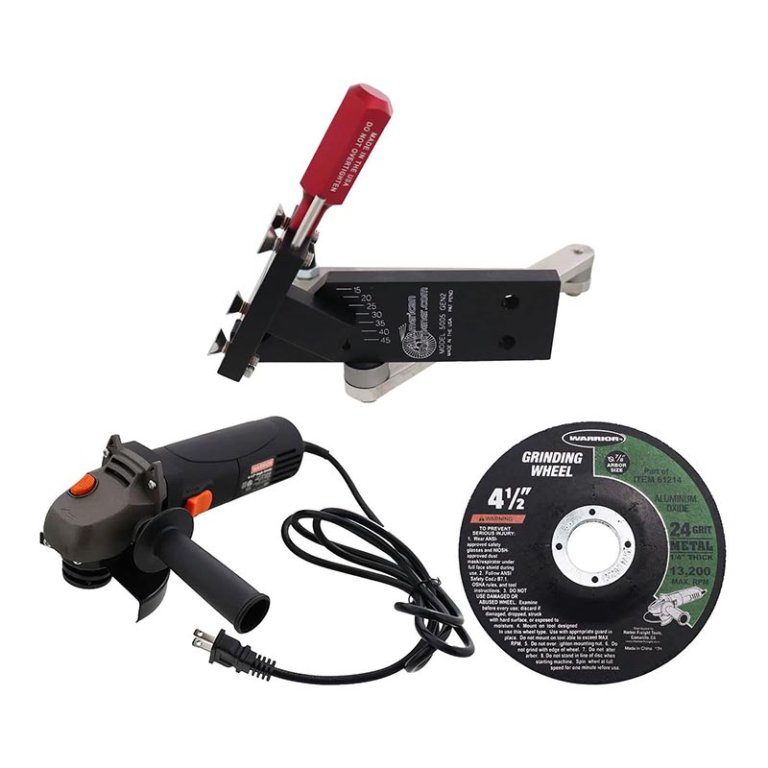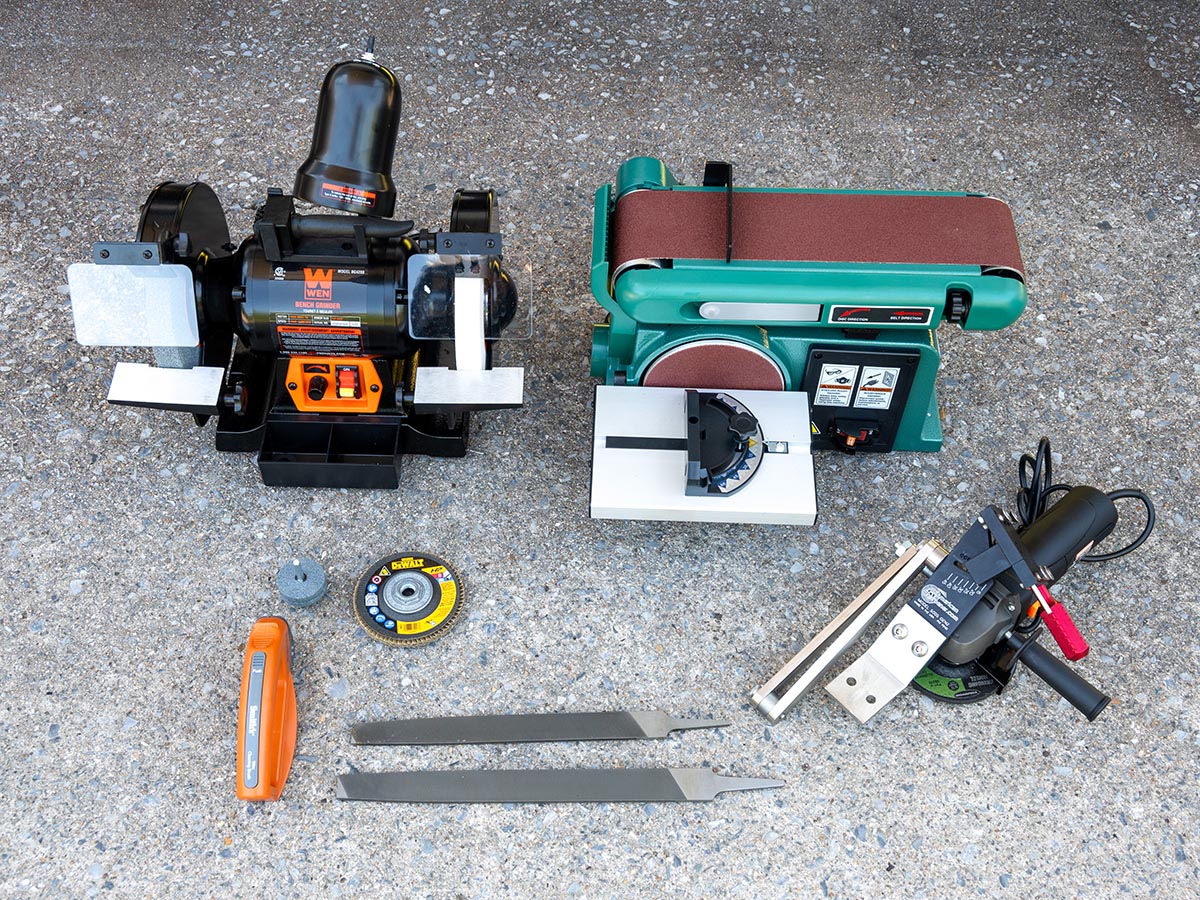
We may earn revenue from the products available on this page and participate in affiliate programs. Learn More ›
A dull mower blade cuts poorly and makes it harder to mow, but a lawn mower blade sharpener can fix that problem. For best results, users will want to sharpen mower blades every 20 to 25 hours of mowing. The good news is that sharpening mower blades is an easy DIY maintenance project if you have the right equipment—and there are a wide variety of tools from which to choose, including manual files, power grinders, various jigs, and more. In our search for the best options, we tested eight vastly different lawn mower blade sharpeners on 16 dull lawn mower blades.
Our favorite product is the Crescent Nicholson 12″ Flat Double-Cut Bastard File. This is a simple, inexpensive, and highly effective tool that renews a worn mower blade with just a few strokes. It is easy to store when not in use, and you’ll likely find it also serves other purposes around the home and workshop. We also have recommendations for shoppers who value speed and precision over affordability. Read on to learn more about our product reviews and additional considerations to help you select the best lawn mower blade sharpener for your workshop or hand tool box.
- BEST OVERALL: Crescent Nicholson 12″ Flat Double-Cut Bastard File
↓ Jump to Review - BEST BANG FOR THE BUCK: Smith’s Lawn Mower Blade Sharpener
↓ Jump to Review - BEST DRILL ATTACHMENT: Ankda Double-Layer Lawn Mower Blade Sharpener
↓ Jump to Review - BEST FILE: Crescent Nicholson 14″ Mill Single-Cut Bastard File
↓ Jump to Review - BEST ANGLE GRINDER DISC: DeWalt 4½” by ⅝” 24G Type 29 HP Flap Disc
↓ Jump to Review - BEST BENCH GRINDER: Wen 8″ 5-Amp Variable-Speed Bench Grinder
↓ Jump to Review - BEST BELT GRINDER: Grizzly Industrial Horizontal/Vertical Belt Sander
↓ Jump to Review - BEST SYSTEM: All American Sharpener Model 5005 Gen 2 Kit
↓ Jump to Review
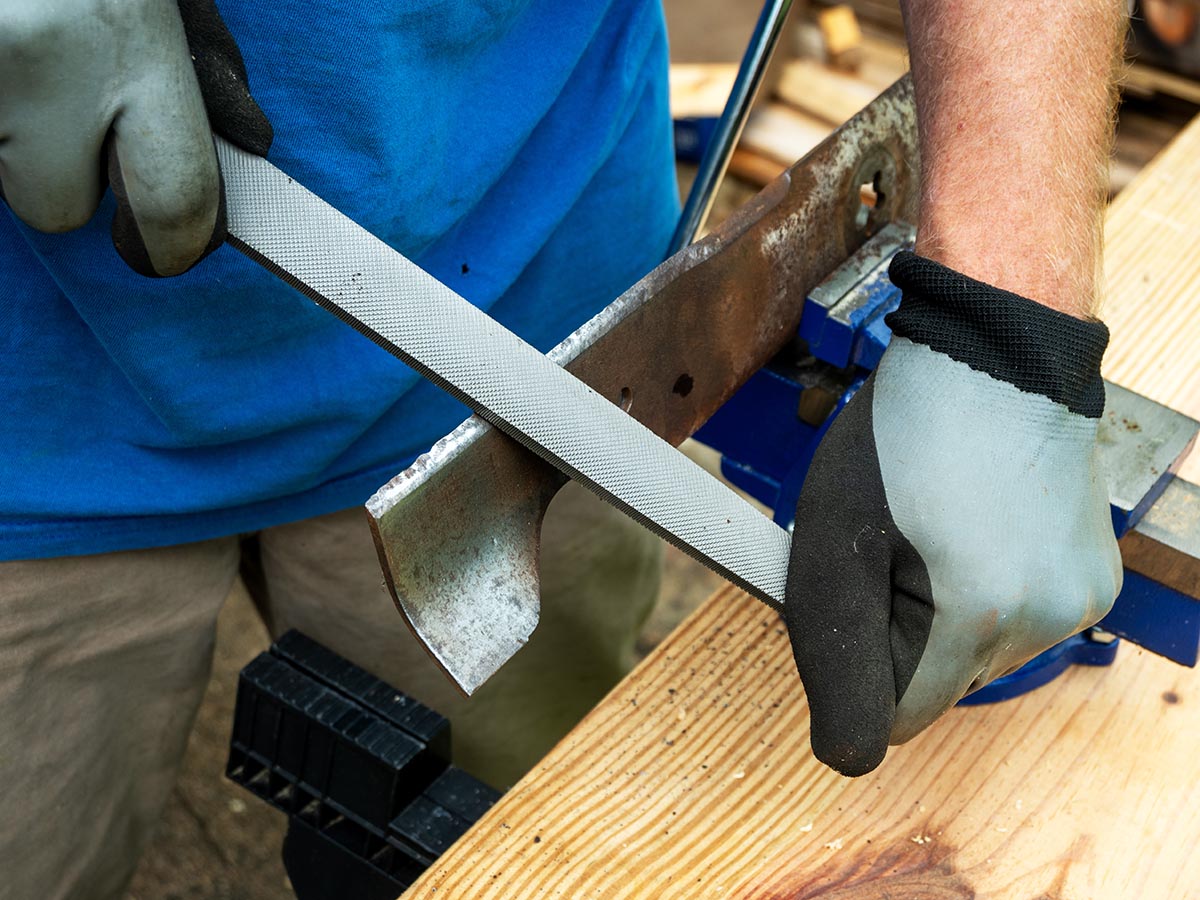
| Type | Sharpener material | Versatility | |
| Crescent Nicholson 12″ Flat Double-Cut Bastard File | Manual | Steel | Most cutting and digging tools |
| Smith’s Lawn Mower Blade Sharpener | Manual | Carbide | Lawn mower only |
| Ankda Double-Layer Lawn Mower Blade Sharpener | Drill attachment | Corundum | Lawn mower blades |
| Crescent Nicholson 14″ Mill Single-Cut Bastard File | Manual | Steel | Most cutting and digging tools |
| DeWalt 4½” by ⅝” 24G Type 29 HP Flap Disc | Electric grinder attachment | Zirconia | Most cutting and digging tools |
| Wen 8″ 5-Amp Variable-Speed Bench Grinder | Bench grinder | Aluminum oxide | Most cutting and digging tools |
| Grizzly Industrial Horizontal/Vertical Belt Sander | Belt grinder/sander | Aluminum oxide | Most cutting tools; woodworking projects |
| All American Sharpener Model 5005 Gen 2 Kit | Grinder attachment | N/A | Lawn mower blades only |
Our Top Picks
The best mower blade sharpener for your situation depends on numerous factors, such as average mowing conditions, frequency of sharpening, and personal preferences, including budget. Our top picks feature a wide range of tools that will perform well in a variety of settings. Whether you value power, precision, speed, or portability, one of these options could be the lawn mower blade sharpener you’ve been looking for.
Best Overall
Crescent Nicholson 12" Flat Double-Cut Bastard
What We Like
- High quality and very affordable
- Compact, lightweight, easy to store and carry
- Fastest of all the manual sharpeners we tested
- Suitable for a variety of tool sharpening needs
What We Don’t Like
- Fast for a file but slower than electric sharpeners
- The file is less precise without a jig
Product Specs
- Type: Manual
- Sharpener material: Steel
- Versatility: Most cutting and digging tools
Our Ratings: Setup 5/5; Ease of Use 4.8/5; Sharpening 5/5; Quality 5/5; Value 5/5
Maintaining your lawn mower doesn’t have to be expensive or time-consuming. If you appreciate the simplicity and quiet satisfaction of working with manual tools, then the Crescent Nicholson 12-inch flat double-cut bastard file is a great option. The aggressive double-cut teeth remove material fast with moderate pressure, making it possibly the best file for sharpening lawn mower blades. The 12-inch length accommodates two-handed operation, and it easily fits in a tool box.
We spent 30 minutes sharpening two mower blades with this file. With the blade clamped in a bench vice, we followed the established blade angle with long file strokes. Applying moderate pressure, the file removed a lot of material quickly. It only took 10 strokes on each end to sharpen the first blade, which was dull from a full season’s usage but had no nicks or chips. The second blade, which had a few deep gouges from encounters with hidden rocks, needed about twice as many strokes to renew the edge and rebalance the blade.
We chose this product as our Best Overall pick because it is inexpensive, versatile, and very effective. We could work with any blade angle to accommodate various mower blade types—or other edged tools for that matter. We also adjusted downward pressure as needed for more or less material removal per stroke. The finish was fairly smooth, but some users may want to hone it with a medium file or sharpening stone. It takes a little practice to perfect the process, and the total sharpening time was less than 15 minutes per mower blade.
Get the Crescent Nicholson 12-inch lawn mower blade sharpener at The Home Depot, ToolUp.com, or IndustrialSafety.com.
Best Bang for the Buck
Smith's Lawn Mower Blade Sharpener
What We Like
- Mower-specific design for working quickly
- Built-in brush for cleaning mower blade
- Oversize handle to protect hands
- Compact and lightweight; fits in a tool box
What We Don’t Like
- Only compatible with standard mower blades
- Not able to rebalance a damaged blade
Product Specs
- Type: Manual
- Sharpener material: Carbide
- Versatility: Lawn mower only
Our Ratings: Setup 5/5; Ease of Use 5/5; Sharpening 4/5; Quality 4/5; Value 5/5
Manual lawn mower sharpening can be tricky, but with a tool specifically designed for lawn mower blades like this model from Smith’s, precise results can happen quickly. This handheld manual blade sharpener features a carbide bar and a preset angle with a guide, which are both ideal for standard mower blades. The design removes the guesswork and provides quick and easy honing, making it the best mower blade sharpening tool that is not a file or power grinder.
Unlike basic garden sharpeners, Smith’s lawn mower blade sharpener offers a large, robust design with an oversize blade guard. This makes handling the tool with gloved hands easy while also keeping fingers clear of the blade. A built-in wire brush is effective for cleaning caked-on debris from the blade before sharpening. Keep in mind that the mower blade-specific single-bevel design does limit this tool’s versatility, preventing it from sharpening other tools effectively.
We selected a mildly worn blade and a deeply nicked blade to test this sharpener. It did a good job resetting the edge on the first blade after a dozen strokes on each end. The second blade presented a bit more of a challenge. After 24 strokes on each end, the undamaged portions of the blade were sharp, but the lower edges of the nicked areas were rounded over, and the blade was out of balance. We resorted to using a file to correct these issues. This sharpener is inexpensive and extremely easy to use, but may not be adequate for lawns with rocks, shallow tree roots, or other damaging obstacles present.
Get the Smith’s lawn mower blade sharpener at Amazon, Menard’s, or Scheels.
Best Drill Attachment
Ankda Double-Layer Lawn Mower Blade Sharpener
What We Like
- Simple setup with repeatable results
- Affordable price point
- Includes 3 sets of stones
What We Don’t Like
- Somewhat awkward to hold
- Only useful for lawn mowers
Product Specs
- Type: Drill attachment
- Sharpener material: Corundum
- Versatility: Lawn mower blades
Our Ratings: Setup 4/5; Ease of Use 4/5; Sharpening 4/5; Quality 4/5; Value 4/5
For users who want the sharpening speed of an electric grinder without the expense and storage requirements, a grindstone on a drill bit might make sense. This Ankda double-layer corundum lawn mower blade sharpener could be the ideal product. This kit includes three sets of grinding stones—each with a preset 40-degree angled sharpening guide for a sharp and durable blade angle—and a blade balance.
We found the kit to be easy to set up and use. Simply tighten the grinder wheel’s shaft in the drill chuck, register the blue guide on the mower blade, activate the drill, and guide the stone across the mower blade. The preset angles allow for repeatable results; however, they’re only useful for lawn mowers.
In our tests, these bits did a tolerable job. They worked fast, but we found it difficult to hold the drill at the precise angle all the way through the stroke. Ultimately, both of the test blades ended up in better shape than before, so we considered it a success. If you already own a drill but not a grinder, this could be the next best thing with a little practice.
Get the Ankda lawn mower blade sharpener at Amazon.
Best File
Crescent Nicholson 14" Mill Single-Cut Bastard File
What We Like
- Leaves a finer finish than other sharpeners we tested
- Versatile; sharpens a variety of edged tools
- Lightweight and compact; fits in a tool box
What We Don’t Like
- Not as fast as a double-cut file
- Requires practice to achieve great results
Product Specs
- Type: Manual
- Sharpener material: Steel
- Versatility: Most cutting and digging tools
Our Ratings: Setup 5/5; Ease of Use 5/5; Sharpening 4/5; Quality 5/5; Value 4.5/5
For a more refined hand-sharpened finish, a single-cut file can be a great choice. The Crescent Nicholson 14-inch single-cut bastard file cuts less aggressively than a double-cut file, and the extra length allows a longer, more efficient two-handed stroke. This is the best file for the smoothest, cleanest cutting edge.
Two things became apparent as we tested this model. First, it creates a superior finish compared to the double-cut file or the manual lawn mower sharpener. Second, it does so slowly. Sharpening our test blades required nearly twice as many strokes with this file—18 on the mildly worn blade and 39 on the nicked blade—compared to our Best Overall pick. However, the edge was extra smooth when we finished, with few visible tool marks.
This file might be a favorite of users who prefer to hone their blades after every 10 to 15 hours of mowing before they become severely worn. This tool is also excellent for refining the cutting edge after power grinding or filing with a double-cut file.
Get the Crescent Nicholson 14-inch lawn mower blade sharpener at Amazon, Travers Tool, All Industrial Tool Supply, or Hayes Instrument Co.
Best Angle Grinder Disc
DeWalt 4½" by ⅝" 24G Type 29 HP Flap Disc
What We Like
- Coarse synthetic grit removes material quickly
- Works with most 4- to 5-inch handheld angle grinders
- Lowest cost option, if you already own the grinder
- Many other uses in metalwork beyond sharpening
What We Don’t Like
- Requires an expensive handheld grinder
- Imprecise way to sharpen without a jig
Product Specs
- Type: Electric grinder attachment
- Sharpener material: Zirconia
- Versatility: Most cutting and digging tools
Our Ratings: Setup 4/5; Ease of Use 5/5; Sharpening 5/5; Quality 5/5; Value 5/5
If you already own a handheld angle grinder, why not put it to use? The DeWalt DW8311 flap disc is the perfect attachment for sharpening lawn mower blades and can also assist with other grinding, sharpening, rust removal, and finishing projects. The wheel is embedded with 36-grit zirconia for fast material removal that can quickly repair rolled edges and nicks in the blade.
One of the risks that comes with power grinding a mower blade is the buildup of heat in the blade that can make the cutting edge brittle. The aggressive abrasive material embedded in this flap disc counters that risk by working fast, removing material quickly before heat buildup becomes an issue.
In our tests, we were able to move the grinder quickly along the blades and achieved a like-new edge in just six passes on the moderately worn edges and 13 passes on the deeply pitted edges. This product also did a great job when it came time to rebalance after sharpening.
Get the DeWalt lawn mower blade sharpener at Grainger.
Best Bench Grinder
Wen 8" 5-Amp Variable-Speed Bench Grinder
What We Like
- Multipurpose bench grinder for all kinds of metalwork
- 36-grit wheel for quick edge repairs; 80-grit wheel for honing
- Secure bench-mount system
- Fast repeatable results
What We Don’t Like
- Expensive if used only to sharpen mower blades
- Not portable
Product Specs
- Type: Bench grinder
- Sharpener material: Aluminum oxide
- Versatility: Most cutting and digging tools
Our Ratings: Setup 5/5; Ease of Use 5/5; Sharpening 5/5; Quality 4.5/5; Value 4.7/5
Buying a bench grinder might seem excessive for the simple task of sharpening a lawn mower blade, but it could become one of the most versatile tools in the shop. The Wen 8-inch 5-amp variable-speed bench grinder sharpens and deburs mower blades, pruners, axes, shears, and other yard tools as well as drill bits, chisels, woodworking tools, and more.
This bench grinder comes equipped with two aluminum-oxide grinding wheels—36-grit and 80-grit—for fast metal removal and more delicate honing. A control dial adjusts the wheel speed from 2,000 to 3,400 revolutions per minute. Each wheel has an adjustable tool rest, spark arrester, and shield, and a built-in work light boosts visibility.
In our tests, using the coarse wheel and faster speed, the Wen bench grinder made it extremely easy to remove the nicks and dents from the badly worn blade. We used the medium wheel to sharpen the moderately dull blade in less than 5 minutes. We appreciated the larger diameter of the 8-inch wheels because they allowed working clearance between the long mower blade and the electric motor housing.
Sharpening a mower blade once a year may not justify the price of the grinder when a flat file does the job just as well. However, it adds to the aggregate of problems that the grinder would solve and the tools it would save, so this grinder could be the right pick in the long run.
Get the Wen lawn mower blade sharpener at Amazon, Lowe’s, The Home Depot, or Northern Tool + Equipment.
Best Belt Grinder
Grizzly Industrial Horizontal/Vertical Belt Sander
What We Like
- Multipurpose shop tool for sanding and grinding
- Lower risk of damage from heat buildup
- Sharpens quickly
- Easy to adjust/change grit
What We Don’t Like
- Included 80-grit belt is not aggressive
- Requires practice to achieve precision
Product Specs
- Type: Belt grinder/sander
- Sharpener material: Aluminum oxide
- Versatility: Most cutting tools; woodworking projects
Our Ratings: Setup 5/5; Ease of Use 5/5; Sharpening 4/5; Quality 5/5; Value 4.7/5
Belt sanders, or grinders, are versatile tools. The 36-inch-long by 4-inch-wide 80-grit aluminum-oxide abrasive belt on the Grizzly Industrial horizontal/vertical belt sander works well on wood or metal projects, including sharpening mower blades. It packs a 4.3-amp single-phase motor that turns the belt at a rate of 1,900 feet per minute. The 90-degree adjustable belt platen and right-angle backstop allow vertical, diagonal, or horizontal sanding for optimal user comfort and control.
This was one of our fastest tests. The best grit for sharpening lawn mower blades depends on the blade condition and user preference, and we found this 80-grit belt performed successfully. The 4-inch abrasive belt perfectly matched the width of the sharp edges on our 21.5-inch mower blades. We raised the belt platen to the vertical position, flipped the power switch, and braced the blade against the backstop as it contacted the belt. The moderately worn blade only needed a 12-second grind on each edge, while the severely worn blade required 27 seconds per edge.
This product ranks as one of the more expensive options in this guide, but it is also one of the best in terms of speed and edge quality. We liked that the Grizzly belt sander gave the edge an evenly flat profile, and the included 80-grit belt left a smooth finish. The bench grinder and angle grinders created a slightly concave profile, which makes the cutting edge thinner and less durable. The manual files also created a flat profile, but they were slower and less precise.
Get the Grizzly Industrial lawn mower blade sharpener at The Home Depot, Tractor Supply Co., or Grizzly Industrial.
Best System
All American Sharpener Model 5005 Gen 2 Kit
What We Like
- Adjusts to 45 degrees
- Attaches to traditional grinders and workbenches
- Easy to set up and use for consistent results
What We Don’t Like
- Requires an angle grinder
Product Specs
- Type: Grinder attachment
- Sharpener material: N/A
- Versatility: Lawn mower blades only
Our Ratings: Setup 4/5; Ease of Use 5/5; Sharpening 5/5; Quality 5/5; Value 4.3/5
The All American sharpener model 5005 kit is worth a look for anyone who wants to put a precision edge on their mower blade in as little time as possible. This durable arm bolts directly to a workbench to provide a stable platform for the blade. The grinder then attaches to the arm at an angle chosen by the user. The arm guides the grinder at a precise angle across the blade’s edge, renewing the edge in seconds.
This system adjusts to several angles between 15 and 45 degrees, accommodating standard, mulching, and high-lift mower blades. The kit we tested included an angle grinder and a 24-grit aluminum-oxide grinding wheel, which worked well, but we obtained a keener edge with the previously mentioned DeWalt flap disc. The All American sharpener 5005 is also available without the grinder for buyers who already own one. The kit includes an assortment of guide pins that attach to the threaded grinder handle receptacle, making it compatible with most brands.
In our tests, assembly took about 10 minutes, including bolting the base to our benchtop—it’s also compatible with wall installation—and setting up the grinder. After clamping a lawn mower blade into the vise, we ensured that the grinder wheel was centered on the blade edge before sharpening. This system gave us the most consistent, repeatable results of the products in this guide, and the power grinder made quick work of dull, damaged blades. The jig took up less space than the Wen bench grinder or the Grizzly Industrial belt sander but delivered equally fast results with the best precision.
Get the All American lawn mower blade sharpener at Amazon or All American Sharpener.
Jump to Our Top Picks
How We Tested the Best Lawn Mower Blade Sharpeners
| Testing Stats | |
| Products tested | 8 |
| Time spent testing | 6 hours |
| Tests performed | 4 |
| Price range | $13 to $306 |
To assess these mower blade sharpeners, we considered speed, precision, versatility, the sharpened blade’s finish, and price. We also wanted to replicate different usage patterns, so we sharpened two types of blades with each tool. The first type of blade was like that of a serious lawn enthusiast who maintains a pristine lawn. This blade becomes dull but never pitted or chipped from contact with hard obstacles. The second type of blade was that of a casual owner who just keeps the grass at an acceptable length. This blade receives dents and nicks from encounters with sticks, rocks, roots, obscured toys, and maybe an occasional hidden stepping stone.
After a half day of lawn mower blade sharpening, we recorded our observations and scored each mower blade sharpener on a rubric. Then, considering our assessment objectives and user-type avatars, we awarded a title to each product that best represented its strengths.
| Setup | Ease of Use | Sharpening | Quality | Value | |
| Crescent Nicholson 12″ Flat Double-Cut Bastard File | 5/5 | 4.8/5 | 5/5 | 5/5 | 5/5 |
| Smith’s Lawn Mower Blade Sharpener | 5/5 | 5/5 | 4/5 | 4/5 | 5/5 |
| Ankda Double-Layer Lawn Mower Blade Sharpener | 4/5 | 4/5 | 4/5 | 4/5 | 4/5 |
| Crescent Nicholson 14″ Mill Single-Cut Bastard File | 5/5 | 5/5 | 4/5 | 5/5 | 4.5/5 |
| DeWalt 4½” by ⅝” 24G Type 29 HP Flap Disc | 4/5 | 5/5 | 5/5 | 5/5 | 5/5 |
| Wen 8″ 5-Amp Variable-Speed Bench Grinder | 5/5 | 5/5 | 5/5 | 4.5/5 | 4.7/5 |
| Grizzly Industrial Horizontal/Vertical Belt Sander | 5/5 | 5/5 | 4/5 | 5/5 | 4.7/5 |
| All American Sharpener Model 5005 Gen 2 Kit | 4/5 | 5/5 | 5/5 | 5/5 | 4.3/5 |
What to Consider When Choosing a Lawn Mower Blade Sharpener
There’s more to maintaining a sharp edge on a lawn mower blade than simply dragging it across a grinder. The following section will explain all the information that shoppers need to choose the best tool to sharpen lawn mower blades for their specific requirements.
Type and Speed
There are three basic types of lawn mower blade sharpeners: options that work with grinders, options that work with drills, and manual options. The models that work with grinders typically attach to them and hold the blade in specific positions. Then, the models that work with drills fit in the chuck and spin a grinder stone at high speed, with the user dragging them across the edge of the blade to revive it. Last, manual models typically require the user to drag the blade through the sharpener repeatedly to hone the edge.
In terms of speed, users will want to consider how much time they want to spend grinding a mower blade. Sharpeners that attach to grinders typically work quickly, as the user can grind more material faster than they can with other models. Sharpeners that attach to drills are still relatively fast, although they require constant movement and grind only a very small amount of the blade at a time. Manual sharpeners are often extremely slow, requiring 30 minutes or more to hone an edge.
Compatibility and Versatility
Lawn mower blades aren’t necessarily one-size-fits-all. For this reason, DIYers will want to find a sharpener that can handle a variety of mower blades. For example, models that can handle standard or medium-lift blades, low-lift blades, high-lift blades, and mulching blades will adapt to most scenarios with ease. These sharpeners can match the curves or contours of the blade, resulting in a smooth, sharp edge.
Consider the sharpener’s versatility as well. Some mower blade sharpeners can also sharpen knives, scissors, axes, and other tools while other models are only capable of sharpening mower blades. It may be worth shopping for a more versatile mower blade sharpening tool to keep all of your tools and blades sharp.
Sharpener and Guide Material
Regardless of the type of lawn mower blade sharpener, these tools work by removing metal from the blade. To do so, the sharpener itself must be made of a material that is harder than tool steel. The two materials most commonly used for this task are carbide steel and corundum. Carbide steel works well in handheld sharpeners, whereas corundum is a better choice for grinders and drill-type sharpeners due to its ability to sharpen a mower blade at high speeds. However, the best grinding wheel for sharpening lawn mower blades might contain a mixture of materials.
There are many options from which to choose when it comes to guide material. Plastic, steel, and aluminum are all popular choices, and budget will typically determine the material each model features.
Keep in mind that some blade sharpening tools come with changeable belts. These belts allow the user to choose the best grit for sharpening lawn mower blades, but also switch to fine grinding work for knives or chisels.
Ease of Use
A drill sharpener must be easy to use; otherwise, you’ll be more likely to purchase a new blade and leave the sharpener stashed in the garage. Mower blade sharpeners that are hard to set up, take a lot of practice to perfect, or simply take forever to achieve the sharp edge you’re looking for aren’t going to cut it.
Alternatively, look for sharpeners that set up easily or, better yet, don’t require any setup at all. The best tool for sharpening lawn mower blades will be easy to use and create consistent results, lessening the amount of time it takes to figure them out.
Safety
While lawn mower blade sharpeners aren’t creating razor-sharp blades, there is still some danger involved in blade sharpening. Almost any time friction exists between two pieces of metal—in this case, the blade and the sharpener—users will want to proceed with caution.
Remember to always wear gloves and eye protection while sharpening blades on mowers. Small metal shavings can become airborne and embed themselves, causing painful injuries. Ear protection may also be necessary when using a grinder or a drill to avoid damaging your hearing. Additionally, make sure to keep fingers behind or inside of the guard when using a handheld manual sharpener.
Tips for Using Lawn Mower Blade Sharpeners
Lawn mower blades don’t need to be razor-sharp to be effective. In general, grinding a 35- to 45-degree angle on a lawn mower blade will result in a durable edge that is sharp enough to avoid damaging the grass. Finer angles can dull quickly, while steeper angles will struggle to cut effectively.
Sometimes, speed is the enemy. Grinders that spin too quickly can create excessive heat in the lawn mower blade, causing it to become brittle. Additionally, remember to keep the blade (or grinder) moving to prevent heat buildup in one area.
FAQs
Even with all this information on the best lawn mower blade sharpener for your needs, there could still be some questions to chop away at. Keep reading to learn some of the most frequently asked questions about these tools, and check for an answer to your question listed below.
Frayed or broken blades of grass are a good sign that the blade requires sharpening. (However, they’re also a telltale sign of an inexperienced mower.) Furthermore, if the motor starts to bog down or struggle, it could be a sign that the blade isn’t cutting effectively.
Generally speaking, you’ll want to sharpen lawn mower blades once or twice a growing season. That said, hitting rocks, logs, and other obstructions will dull a blade right away, so you may need to sharpen them more frequently.
Yes, some sharpeners can create a serviceable edge on lawn mower blades without you having to take them off. Simply turn the mower on its side so the carburetor is pointing upward and use the sharpener on the blade. Be sure to remove the spark plug wire to prevent an accidental start-up.
A blade honed to a very fine angle can be too sharp. While this type of blade can cut extremely well at first, it will dull quickly and ultimately damage the grass. Sharpening a blade at angles between 35 and 45 degrees is typically best.
You can sharpen lawn mower blades until you’ve removed 1 inch of the original width from the cutting edges. At that point, you will want to replace them with new blades.
Meet the Tester
Mark Wolfe is a writer and product tester with a background in the nursery and landscaping industries. For more than 20 years, he mowed, edged, planted, pruned, cultivated, irrigated, and renovated beautiful landscapes. Now, he tests and writes reviews about the latest outdoor power equipment, hand tools, lawn care products, and other outdoor living goods.
Additional research by Tom Scalisi.
